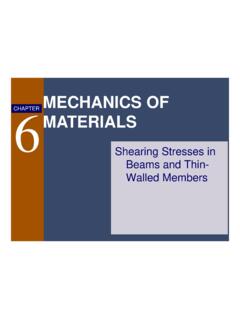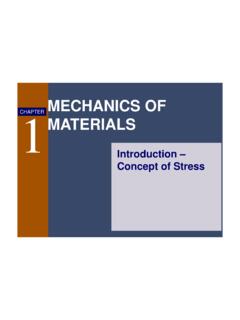Transcription of Flexible pavement design.ppt
1 Flexible pavement DesignMechanistic Method of pavement DesignAssume pavement ConfigurationCompute pavement ResponsesUsing Structural ModelsCompute AllowableNumber of Repetitions of Standard Axle Using Distress ModelsFind Expected Number ofRepetitions of Standard Axle on Design Lane from Traffic AnalysisDRSatisfactory?Final DesignYesNoInput Material Properties Axle Load Failure Criteria ReliabilityDesign Procedure of IRC Design Approach and Criteria The following three types of pavement distress resulting from repeated application of traffic are considered:(i) Horizontal tensile strain at the bottom of the bituminous layer(ii) Vertical compressive strain at the top of the subgrade(iii)
2 pavement deformation with in the bituminous layer The deformation with in the bituminous layer is assumed to be controlled by meeting the mix design requirements Failure Criteria Fatigue Cracking Is due to the build up of tensile strain at the bottom of Asphaltic Concrete Layer pavement is considered failed if 20% of the surface has cracked Rutting Failure Is due to the build up of excessive compressive strain at the top of subgrade layer pavement is considered failed if it exhibits a rut depth of 20 Design Approach and Criteria The pavement has been modeled as a three layer structure and stresses and strains at critical locations have been computed using the linear elastic structural model Cracking and RuttingAsphalt Surface CourseAsphalt Binder CourseUnbound baseGranular SubbaseCompacted SubgradeNatural Subgrade c tWheel LoadFatigue CrackingRuttingLayer 1 Layer 2 Layer 3 Fatigue Cracking Model21kkt3fE1 1kN =Nf= No.
3 Of cumulative standard axles to produce 20% cracked surface area t= Tensile strain at the bottom of Bituminous Concrete layerE = Elastic Modulus of Bituminous Surface (MPa)k1, k2 = Laboratory calibrated parametersK3= Transfer parameterIRC Fatigue Cracking ModelFatigue Cracking modelNf= No. of cumulative standard axles to produce 20% cracked surface area t= Tensile strain at the bottom of Bituminous Concrete layerE = Elastic Modulus of Bituminous Surface (MPa) = ENtf Rutting Failure Model415kcRkN = NR= No. of Repetitions to Rutting failure c= Vertical subgrade straink4, k5 = Calibrated parametersIRC Rutting Failure ModelRutting modelNR= No.
4 Of cumulative standard axles to produce 20mm rutting c= Vertical subgrade = cRN Traffic Traffic is considered in terms of the cumulative number of standard axles (8160 kg) to be carried by the pavement during the design life For estimating the design traffic, the following Information is needed: Initial traffic after construction (CVPD) Traffic growth rate during the design life By studying the past trends of traffic growth As per the econometric procedure outlined in Between CBR and ESubgradeE (MPa) = 10 * CBR if CBR<5% and= 176 *(CBR) for CBR > 5%Granular subbase and baseE2= E3* * Composite modulus of sub-base and base (MPa)E3= Modulus of subgrade (MPa)h = Thickness of granular layers (mm)
5 Modulus Values for Bituminous MaterialsMix TypeTemperature oC2025303540AC/DBM 80/100 bitumen 2300 1966 1455 975797AC/DBM 60/70 bitumen3600 3126 2579 1695 1270AC/DBM 30/40 bitumen6000 4928 3809 2944 2276BM 80/100 bitumen---500-BM 60/70 bitumen---700-Default Values of Poisson s Ratio ( )(as suggested in IRC:37-2001) Subgrade and unbound granular layers Default value of = Bituminous Layers Default value of at 35/45 oC = Default value of at 20 - 30 oC = Design life in number of years NH & SH 15 years Expressways & Urban Roads 20 years Other roads 10 to 15 years Vehicle damage factor (VDF) Need to be worked out from axle load survey Distribution of commercial traffic over the carriageway.
6 (D & L Factors)Computation of design traffic= The cumulative number of standard axles to be catered for in the design in terms of Initial traffic in the year of completion of construction in terms of the number of the commercial vehicles per **]1)1[(*365 +=NA= Lane distribution factor=Vehicle damage factor= Design life in years=Annual growth rate of commercial vehiclesDFnrTraffic in the year of completion= Number of commercial vehicles as per last count = Number of years between the last count and the year of the completion of construction xrPA)1(+=PxSubgrade The subgrade should be compacted to 97% of the dry density achieved with heavy compaction (modified proctor density) as per IS:2720 (Part 8).
7 For Expressways, National Highways and State Highways, the material used for subgrade construction should have the dry density of not less than gm/cc. For determining the CBR value, the standard test procedure described in IS:2720 (Part 16) should be strictly adhered to. The test must always be performed on remoulded samples of soils in the laboratory It is recommended that the samples be soaked in water for four days prior to testing In situ CBR test is not recommendedSubgradePavement CompositionSub-base course Granular Sub-base (GSB) materials conforming to clause 401 of MORT&H specifications for road and bridge works is recommended The sub-base material should have minimum CBR of 20% for cumulative traffic up to 2 msa and 30% for traffic exceeding 2 msa.
8 The material should be tested for CBR at the dry density and moisture content expected in the field. The thickness of sub-base should not be less than 150 mm for design traffic less than 10 msa and 200 mm for design traffic of 10 msa and above. Sub-base Course Preferably the subgrade soil should have a CBR of 2% If the CBR<2%, the design should be based on a CBR of 2% and a capping layer of 150 mm thickness of material with a minimum CBR of 10% shall be provided in addition to the sub-base Where stage construction is adopted, the thickness of sub-base shall be provided for ultimate pavement section for the full design lifeBase course The recommended minimum thickness of granular base is 225 mm for traffic upto 2 msa and 250 mm for traffic exceeding 2 msa.
9 For heavily trafficked roads, use of WMM base laid by paver finisher or motor grader is recommended. Where WBM construction should be adopted in the base course for roads carrying traffic more than 10 msa, the thickness of WBM shall be increased from 250 mm to 300 Surfacing Shall consists of either a wearing course or a binder course with a wearing course depending upon the traffic to be carried. The selection criteria for the grade of bitumen to be used for bituminous courses are given in the table shown in the next slide. Where the wearing course adopted is premix carpet of thickness up to 25 mm, the thickness of surfacing should not be counted towards the total thickness of the.
10 Criteria for the selection of grade of Bitumen for Bituminous coursesClimateTraffic (CVD)Bituminous courseGrade of Bitumen to be usedHotAnyBM, BPM, BUSG60/70 Moderate/ColdAnyBM, BPM, BUSG80/100 AnyHeavy Loads, Expressways, Urban RoadsDBM, SDBC, BC60/70 Hot/ModerateAnyPremix Carpet50/60 or 60/70 ColdAnyPremix Carpet80/100 Hot/ModerateAnyMastic Asphalt15 5 ColdAnyMastic Asphalt30/40 IRC pavement Design CataloguePavement Thickness Design Chart for Traffic 1-10 msaPavement Thickness Design Chart for Traffic 10-150 msaExample A new four lane divided highway is to be constructed on a subgrade of CBR %.











